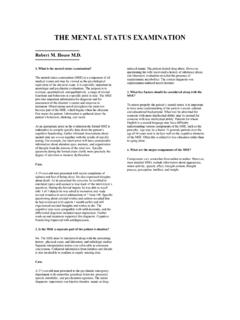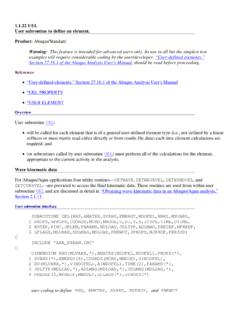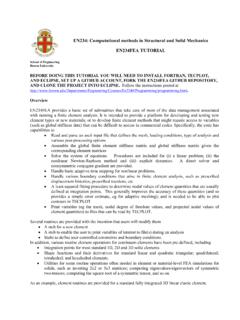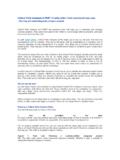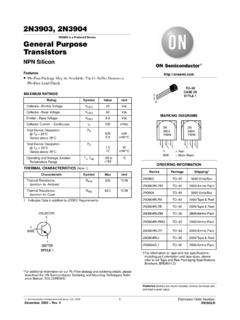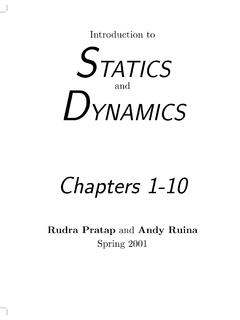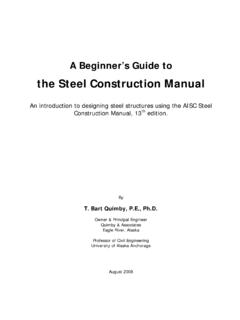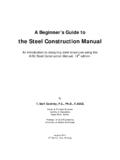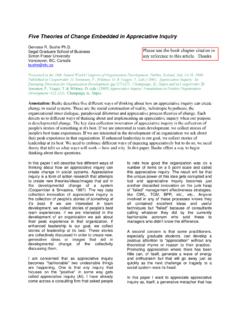Transcription of Chapter 2 Review of Forces and Moments - Brown …
1 Chapter 2 Review of Forces and Moments Forces In this Chapter we Review the basic concepts of Forces , and force laws. Most of this material is identical to material covered in EN030, and is provided here as a Review . There are a few additional sections for example Forces exerted by a damper or dashpot, an inerter, and interatomic Forces are discussed in Section Definition of a force Engineering design calculations nearly always use classical (Newtonian) mechanics. In classical mechanics, the concept of a ` force is based on experimental observations that everything in the universe seems to have a preferred configuration masses appear to attract each other; objects with opposite charges attract one another; magnets can repel or attract one another; you are probably repelled by your professor.
2 But we don t really know why this is (except perhaps the last one). The idea of a force is introduced to quantify the tendency of objects to move towards their preferred configuration. If objects accelerate very quickly towards their preferred configuration, then we say that there s a big force acting on them. If they don t move (or move at constant velocity), then there is no force . We can t see a force ; we can only deduce its existence by observing its effect. Specifically, Forces are defined through Newton s laws of motion 0. A `particle is a small mass at some position in space. 1. When the sum of the Forces acting on a particle is zero, its velocity is constant; 2. The sum of Forces acting on a particle of constant mass is equal to the product of the mass of the particle and its acceleration; 3.
3 The Forces exerted by two particles on each other are equal in magnitude and opposite in direction. Isaac Newton on a bad hair day The second law provides the definition of a force if a mass m has acceleration a, the force F acting on it is m=Fa Of course, there is a big problem with Newton s laws what do we take as a fixed point (and orientation) in order to define acceleration? The general theory of relativity addresses this issue rigorously. But for engineering calculations we can usually take the earth to be fixed, and happily apply Newton s laws. In rare cases where the earth s motion is important, we take the stars far from the solar system to be fixed. Causes of force Forces may arise from a number of different effects, including (i) Gravity; (ii) Electromagnetism or electrostatics; (iii) Pressure exerted by fluid or gas on part of a structure (v) Wind or fluid induced drag or lift Forces ; (vi) Contact Forces , which act wherever a structure or component touches anything; (vii) Friction Forces , which also act at contacts.
4 Some of these Forces can be described by universal laws. For example, gravity Forces can be calculated using Newton s law of gravitation; electrostatic Forces acting between charged particles are governed by Coulomb s law; electromagnetic Forces acting between current carrying wires are governed by Ampere s law; buoyancy Forces are governed by laws describing hydrostatic Forces in fluids. Some of these universal force laws are listed in Section Some Forces have to be measured. For example, to determine friction Forces acting in a machine, you may need to measure the coefficient of friction for the contacting surfaces. Similarly, to determine aerodynamic lift or drag Forces acting on a structure, you would probably need to measure its lift and drag coefficient experimentally.
5 Lift and drag Forces are described in Section Friction Forces are discussed in Section 12. Contact Forces are pressures that act on the small area of contact between two objects. Contact Forces can either be measured, or they can be calculated by analyzing Forces and deformation in the system of interest. Contact Forces are very complicated, and are discussed in more detail in Section 8. Units of force and typical magnitudes In SI units, the standard unit of force is the Newton, given the symbol N. The Newton is a derived unit, defined through Newton s second law of motion a force of 1N causes a 1 kg mass to accelerate at 1 2ms . The fundamental unit of force in the SI convention is kg m/s2 In US units, the standard unit of force is the pound, given the symbol lb or lbf (the latter is an abbreviation for pound force , to distinguish it from pounds weight) A force of 1 lbf causes a mass of 1 slug to accelerate at 1 ft/s2 US units have a frightfully confusing way of representing mass often the mass of an object is reported as weight, in lb or lbm (the latter is an abbreviation for pound mass).
6 The weight of an object in lb is not mass at all it s actually the gravitational force acting on the mass. Therefore, the mass of an object in slugs must be computed from its weight in pounds using the formula 2(lb)(slugs)(ft/s )Wmg= where g= ft/s2 is the acceleration due to gravity. A force of 1 lb(f) causes a mass of 1 lb(m) to accelerate at ft/s2 The conversion factors from lb to N are 1 lb = N 1 N = lb ( is a handy resource, as long as you can tolerate all the hideous ) As a rough guide, a force of 1N is about equal to the weight of a medium sized apple. A few typical force magnitudes (from `The Sizesaurus , by Stephen Strauss, Avon Books, NY, 1997) are listed in the table below force Newtons Pounds ForceGravitational Pull of the Sun on Earth 10 10 Gravitational Pull of the Earth on the Moon 20210 10 Thrust of a Saturn V rocket engine 10 10 Thrust of a large jet engine 10 10 Pull of a large locomotive 5510 10 force between two protons in a nucleus 410 310 Gravitational pull of the earth on a person 10 10 Maximum force exerted upwards by a forearm 10 60
7 Gravitational pull of the earth on a 5 cent coin 10 10 force between an electron and the nucleus of a Hydrogen atom6810 10 Classification of Forces : External Forces , constraint Forces and internal Forces . When analyzing Forces in a structure or machine, it is conventional to classify Forces as external Forces ; constraint Forces or internal Forces . External Forces arise from interaction between the system of interest and its surroundings. Examples of external Forces include gravitational Forces ; lift or drag Forces arising from wind loading; electrostatic and electromagnetic Forces ; and buoyancy Forces ; among others. force laws governing these effects are listed later in this section. Constraint Forces are exerted by one part of a structure on another, through joints, connections or contacts between components.
8 Constraint Forces are very complex, and will be discussed in detail in Section 8. Internal Forces are Forces that act inside a solid part of a structure or component. For example, a stretched rope has a tension force acting inside it, holding the rope together. Most solid objects contain very complex distributions of internal force . These internal Forces ultimately lead to structural failure, and also cause the structure to deform. The purpose of calculating Forces in a structure or component is usually to deduce the internal Forces , so as to be able to design stiff, lightweight and strong components. We will not, unfortunately, be able to develop a full theory of internal Forces in this course a proper discussion requires understanding of partial differential equations, as well as vector and tensor calculus.
9 However, a brief discussion of internal Forces in slender members will be provided in Section 9. Mathematical representation of a force . force is a vector it has a magnitude (specified in Newtons, or lbf, or whatever), and a direction. A force is therefore always expressed mathematically as a vector quantity. To do so, we follow the usual rules, which are described in more detail in the vector tutorial. The procedure is 1. Choose basis vectors {, , }ijk or 12 2{, , }ee e that establish three fixed (and usually perpendicular) directions in space; 2. Using geometry or trigonometry, calculate the force component along each of the three reference directions(, , )xyzFFF or 123(, , )FF F; 3. The vector force is then reported as 112 23 3(appropriate units)xyzFF F F F F=++ = + +Fijke e e For calculations, you will also need to specify the point where the force acts on your system or structure.
10 To do this, you need to report the position vector of the point where the force acts on the structure. The procedure for representing a position vector is also described in detail in the vector tutorial. To do so, you need to: 1. Choose an origin 2. Choose basis vectors {, , }ijk or 12 2{, , }ee e that establish three fixed directions in space (usually we use the same basis for both force and position vectors) xyzFxFyFzijkO3. Specify the distance you need to travel along each direction to get from the origin to the point of application of the force (, , )xyzrrr or 123(, , )rr r 4. The position vector is then reported as 112 23 3(appropriate units)xyzrr r r r r=++ = + +rijke e e Measuring Forces Engineers often need to measure Forces . According to the definition, if we want to measure a force , we need to get hold of a 1 kg mass, have the force act on it somehow, and then measure the acceleration of the mass.
